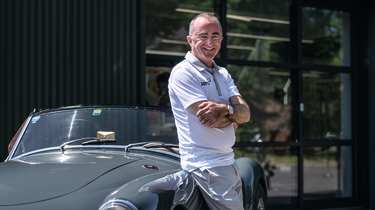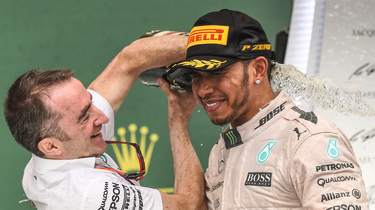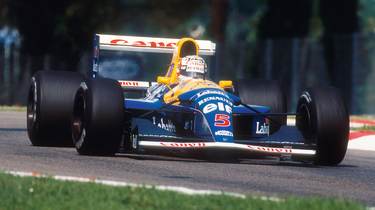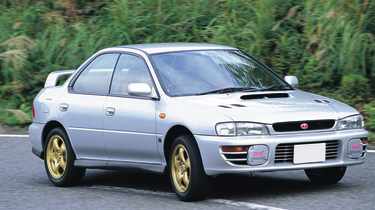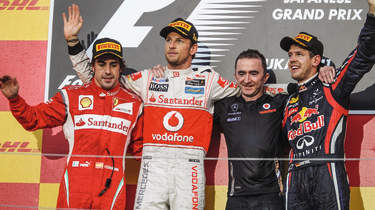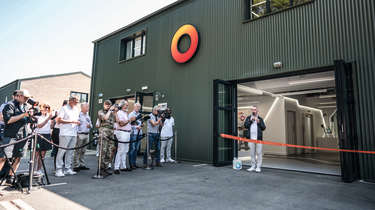My Life & Cars – Paddy Lowe, F1 engineer, efuel pioneer and classic rallying nut
We talk to the F1 engineer who won world championships with Williams, McLaren and Mercedes, and is now heading up the carbon‑neutral fuel company Zero Petroleum
Paddy Lowe worked in Formula 1 for 32 years, winning constructors’ titles with Williams, McLaren and Mercedes, and drivers’ titles with Mansell, Häkkinen and Hamilton, but F1 wasn’t his first or even his second love. ‘The East African Safari Rally used to come past our house every year and I was absolutely crazy about it,’ he recalls. ‘These were the days when it was a proper Safari, when you might only get seven finishers out of the whole field. Pro cars used to come from Europe, Porsche and the like, and generally got beaten by the locals, drivers like Joginder Singh. The only old car I’d love to own is a Datsun 240Z.’
Patrick Allen Lowe was born in Nairobi to parents who were Irish missionaries, and lived in Uganda until the age of 12. ‘We were on our bicycles all day, exploring the neighbourhood, which was quite remote. I grew up with tyre spanners, inner tubes and chains. Then it got a little bit difficult because this was 1974, Idi Amin was in power and it was starting to get a little bit dangerous.’
> My Life & Cars – Martin Brundle, Racing driver and F1 commentator
Relocated to London, Paddy continued to shine academically. Without any real plan, he followed in his brother Michael’s footsteps and studied engineering. ‘I thought, I like the same things as him so that’s obviously what I should do. So I went to the best place I could, Cambridge.’ He was sponsored by the Metal Box Company, a packaging business that invested in young talent hoping that some would stay. ‘It was a thing called a thick sandwich: you did a year training with them, three years in university, and then a year with them after.’
Lowe passed his bike test at 17 and for a few years rode a Triumph Tiger Cub that he’d built from bits. ‘It was old even then, in ’79, but it was quite cool to have this old British bike when everyone else had Yamaha FS1Es.’ He had bikes all through university, earning money as a long-distance dispatch rider between lessons, riding a Kawasaki Z650. ‘Best bike I ever had,’ he says.
Studies complete, he joined Metal Box and lasted almost a year. ‘A friend said, why don’t you work in Formula 1? I never thought that might be a job. There was no internet in those days; you had to find out everything from places like the school library.’ He found the addresses of three teams – Williams, Arrows and Benetton – and wrote to them. Only Frank Dernie at Williams wrote back. Lowe went for an interview and got the job.
‘My degree is in general engineering – at Cambridge they don’t specialise particularly – but I had shown the strongest interest in control systems. The job at Williams was to be a control engineer for the active suspension project. This was September ’87 and they had just decided to race it next season. Not only were they a bit late employing people to do that, they literally had nobody who knew anything about electronics or software...
‘F1 teams were very small in those days. I was around the 100th employee and there were about four or five of us working on active suspension.’ There was a working system that they’d taken to Monza but not raced, and it was famously abandoned at the British Grand Prix in 1988. ‘It was absolutely the right thing to do because it wasn’t ready and there were a lot of other more basic problems with that car,’ says Lowe.
‘We came back in ’92 with a system that was reliable, safe and that delivered. When we started out, the logging was very rudimentary. There were only about 16 channels of data, literally enough to record one lap, so we were very much relying on driver feedback. In the three years we’d developed the infrastructure to support the system, which included recruiting people and building up the knowledge of electronics, instrumentation, hydraulics, data recording and analysis tools.
‘Nigel Mansell was one of our drivers. He’d had the bad experience of the system in ’88, so he was a bit nervous, but as soon as he drove it he realised we now knew what we were doing. And he was a driver that could really exploit it because it was a system that required incredible confidence. Or bravery or lack of imagination! Nigel brought all of that in spades.’ In ’92, the Williams FW14B won the constructors’ title, ending a four-year McLaren streak, and Mansell was drivers’ champion.
The system allowed another innovation: traction control. ‘The first time we tested it was with Damon Hill. He came in and said “I can feel it working but I think it’s holding me back,” and we said, yeah, we can see in the data that it’s working hard, but you’re actually a second per lap quicker…’ The irony was that for all its complexity and time invested, active suspension gave exactly the same: one second per lap. ‘Traction control was just a line of code. I know, I wrote it,’ laughs Lowe.
‘When I came into Formula 1, other than the engine ECU, they were really mechanical teams. There just weren’t electronics or systems or software people there. Almost by default, I was the head of IT for Williams because I was the first person that bought a desktop computer!’
Having been instrumental in delivering active suspension, Lowe left to join McLaren for 1993. ‘I thought it was a good moment to leave and do something different, move up the ladder a bit.’ He came in as head of R&D at McLaren but found there was resistance to new ideas because they’d been so successful, so dominant until Williams beat them. ‘They believed they’d simply messed up and just needed to fix a few errors to get back to winning ways. In fact, there were many technologies they didn’t investigate. That’s why I was there. But there was some resistance to that and it took some years to come through.’ It was another seven years before McLaren claimed the constructors’ title again.
Although Lowe had moved up the ladder, his car tastes remained modest. For many years his daily driver was a lightweight, JDM Impreza STI. ‘I’m not a collector of cars. I’m not even a collector of motorbikes. I imported the Subaru at a cost of £21,000 and the performance per pound was mind-blowing; it would outperform a Porsche any day. I drove it to work every day for seven years and I never had a moment that scared me because it was so well balanced and controlled. It was a four-door, in those days the car of choice for bank robbers; massive boot, you could get the whole gang in easily and no police car could catch it.
‘McLaren always had a bit of an image back then of being grey, a bit dull, but actually we had a really good laugh. I wouldn’t have stayed for 20 years if it wasn’t a great place to work.’ The highlight of his time there? ‘I think 2008 would be the pinnacle, when we got Lewis his championship. It was tooth and nail with Ferrari, you couldn’t leave anything on the table, and we got it in the end. Especially after the disappointment of 2007 when both our drivers missed it by one point. That was a very painful miss.’
Was Lewis a cut above? ‘There are drivers that are really exceptional. Nigel is one of those, Lewis is certainly one of those… Lewis is never the guy you worry about in terms of pushing the car, race craft, can he overtake? He’ll do anything to win. Nigel was the same. That’s what separates the best from the very, very good. And they’re all very, very good.’
From then on at McLaren it started to become frustrating, says Lowe, because they kept coming second. ‘I’m not there to come second. One of the frustrations was having an incredibly talented team that I couldn’t enable to do what they needed to do because there wasn’t the money to do it. We were not resourced to win. That’s ultimately why I left. It was then the opposite at Mercedes.’
Lowe joined the newly formed Mercedes-AMG team as executive director in June 2013. Even knowing how committed they were, he was surprised at how quickly they were successful. ‘They had done what they needed to do on all fronts, made the investment. So in 2014 when the new 1.6-litre V6 turbo regulations came in, their engine was much better than anyone else’s.
‘There was an understanding that it wasn’t a game of efficiency. We were going all-out for wins, not making paper clips, and that meant out-gunning everybody. It’s a different sport now with the cost cap, which brings efficiency to the fore; you’ve got to spend your money on the right things.’
It was an incredibly successful time for Mercedes-AMG, yet after a hat-trick of team titles, in 2017 Lowe left and went back to Williams as CTO. There was to be no quick change of fortune for the team and in 2019 Lowe left. He describes the period as ‘really hard work for no reward whatsoever’ and the only part of his F1 career he didn’t enjoy.
It hasn’t taken the shine off a remarkably successful career. Lowe has seen the sport transition from purely mechanical to the age of electronics, from small scale to teams of 1000, and from innovation to prescription. ‘I’ve lived through that entire transition, through that inversion from “you can do what you like but we’re not very well equipped to deliver it” to “there are very few things we can do but we’re incredibly well equipped to deliver them”. Today, the rule book is very, very thick and opportunities for invention incredibly rare. You really can’t invent a new gearbox or traction control or F-duct; all these things have been closed down. Yet the engineering is incredibly sophisticated and attracts some of the best engineers in the world.’
Re-joining Williams in 2017 wasn’t all bad for Lowe because he reconnected with Simon Wells, then Williams’ operations director. ‘We go back right to the beginning,’ says Lowe. ‘We worked together on the Williams active car. Simon was instrumental in making that system work.’ Wells is now operations director of Lowe’s new venture, Zero, which is aiming to make carbon-neutral synthetic fuels in commercial quantities. Another ex-colleague is Zero’s CTO, Doug McKiernan, the McLaren aerodynamicist who designed many successful cars, including the one that took Lewis to the 2008 title. ‘That’s what we want at Zero,’ says Lowe, ‘friends, colleagues and ex-colleagues, some of the very best people I’ve worked with.’
This story was first featured in evo issue 314.

